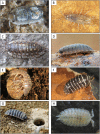The Terrestrial Isopod Microbiome: An All-in-One Toolbox for Animal-Microbe Interactions of Ecological Relevance
- PMID: 27721806
- PMCID: PMC5033963
- DOI: 10.3389/fmicb.2016.01472
The Terrestrial Isopod Microbiome: An All-in-One Toolbox for Animal-Microbe Interactions of Ecological Relevance
Abstract
Bacterial symbionts represent essential drivers of arthropod ecology and evolution, influencing host traits such as nutrition, reproduction, immunity, and speciation. However, the majority of work on arthropod microbiota has been conducted in insects and more studies in non-model species across different ecological niches will be needed to complete our understanding of host-microbiota interactions. In this review, we present terrestrial isopod crustaceans as an emerging model organism to investigate symbiotic associations with potential relevance to ecosystem functioning. Terrestrial isopods comprise a group of crustaceans that have evolved a terrestrial lifestyle and represent keystone species in terrestrial ecosystems, contributing to the decomposition of organic matter and regulating the microbial food web. Since their nutrition is based on plant detritus, it has long been suspected that bacterial symbionts located in the digestive tissues might play an important role in host nutrition via the provisioning of digestive enzymes, thereby enabling the utilization of recalcitrant food compounds (e.g., cellulose or lignins). If this were the case, then (i) the acquisition of these bacteria might have been an important evolutionary prerequisite for the colonization of land by isopods, and (ii) these bacterial symbionts would directly mediate the role of their hosts in ecosystem functioning. Several bacterial symbionts have indeed been discovered in the midgut caeca of terrestrial isopods and some of them might be specific to this group of animals (i.e., Candidatus Hepatoplasma crinochetorum, Candidatus Hepatincola porcellionum, and Rhabdochlamydia porcellionis), while others are well-known intracellular pathogens (Rickettsiella spp.) or reproductive parasites (Wolbachia sp.). Moreover, a recent investigation of the microbiota in Armadillidium vulgare has revealed that this species harbors a highly diverse bacterial community which varies between host populations, suggesting an important share of environmental microbes in the host-associated microbiota. In this review, we synthesize our current knowledge on the terrestrial isopod microbiome and identify future directions to (i) fully understand the functional roles of particular bacteria (both intracellular or intestinal symbionts and environmental gut passengers), and (ii) whether and how the host-associated microbiota could influence the performance of terrestrial isopods as keystone species in soil ecosystems.
Keywords: bacterial diversity; ecological interactions; endosymbionts; microbiota; symbiosis; terrestrial isopods.
Figures





Similar articles
-
Bacterial symbionts in the hepatopancreas of isopods: diversity and environmental transmission.FEMS Microbiol Ecol. 2007 Jul;61(1):141-52. doi: 10.1111/j.1574-6941.2007.00329.x. Epub 2007 May 16. FEMS Microbiol Ecol. 2007. PMID: 17506824
-
Host origin and tissue microhabitat shaping the microbiota of the terrestrial isopod Armadillidium vulgare.FEMS Microbiol Ecol. 2016 May;92(5):fiw063. doi: 10.1093/femsec/fiw063. Epub 2016 Mar 21. FEMS Microbiol Ecol. 2016. PMID: 27004796
-
Host tissues as microhabitats for Wolbachia and quantitative insights into the bacterial community in terrestrial isopods.Mol Ecol. 2014 May;23(10):2619-35. doi: 10.1111/mec.12760. Mol Ecol. 2014. PMID: 24750488
-
Nutrition in terrestrial isopods (Isopoda: Oniscidea): an evolutionary-ecological approach.Biol Rev Camb Philos Soc. 2002 Nov;77(4):455-93. doi: 10.1017/s1464793102005912. Biol Rev Camb Philos Soc. 2002. PMID: 12475050 Review.
-
Bacterial Symbionts in Lepidoptera: Their Diversity, Transmission, and Impact on the Host.Front Microbiol. 2018 Mar 27;9:556. doi: 10.3389/fmicb.2018.00556. eCollection 2018. Front Microbiol. 2018. PMID: 29636736 Free PMC article. Review.
Cited by
-
Functional similarity, despite taxonomical divergence in the millipede gut microbiota, points to a common trophic strategy.Microbiome. 2024 Jan 29;12(1):16. doi: 10.1186/s40168-023-01731-7. Microbiome. 2024. PMID: 38287457 Free PMC article.
-
Metatranscriptomic Analysis Reveals an Imbalance of Hepatopancreatic Flora of Chinese Mitten Crab Eriocheir sinensis with Hepatopancreatic Necrosis Disease.Biology (Basel). 2021 May 23;10(6):462. doi: 10.3390/biology10060462. Biology (Basel). 2021. PMID: 34071147 Free PMC article.
-
Gut microbiomes of mobile predators vary with landscape context and species identity.Ecol Evol. 2017 Sep 12;7(20):8545-8557. doi: 10.1002/ece3.3390. eCollection 2017 Oct. Ecol Evol. 2017. PMID: 29075470 Free PMC article.
-
Lignocellulose degradation in isopods: new insights into the adaptation to terrestrial life.BMC Genomics. 2019 Jun 7;20(1):462. doi: 10.1186/s12864-019-5825-8. BMC Genomics. 2019. PMID: 31174468 Free PMC article.
-
Symbioses of alvinocaridid shrimps from the South West Pacific: No chemosymbiotic diets but conserved gut microbiomes.Environ Microbiol Rep. 2023 Dec;15(6):614-630. doi: 10.1111/1758-2229.13201. Epub 2023 Sep 26. Environ Microbiol Rep. 2023. PMID: 37752716 Free PMC article.
References
-
- Abd E. M., Holdich D. M. (1987). The occurrence of a Rickettsial disease in British woodlice (Crustacea, Isopoda, Oniscidea) populations. J. Invertebr. Pathol. 49 252–258. 10.1016/0022-2011(87)90056-5 - DOI
Publication types
LinkOut - more resources
Full Text Sources
Other Literature Sources
Miscellaneous

